Music
The Realm’s musical tradition is heavily drawn from Wàn music, and focuses on eight primary categories of instruments, each epitomized by a distinct instrument:
- The plucking family, epitomized by the sanxian;
- The bowed family, epitomized by the erhu;
- The picking family, epitomized by the guzheng;
- The striking family, epitomized by the bianqing;
- The pounding family, epitomized by the zhu;
- The hammering family, epitomized by the tanggu;
- The blowing family, epitomized by the dizi; and
- The breathing family, epitomized by the sheng.
In addition to these families, the Realm’s musical tradition also includes vocal performance.
Most of the Realm’s music is pentatonic.
The Eight Noble Instruments
These eight instruments embody their family and are generally regarded as the primary instruments of the Realm’s major musical forms.
Sanxian
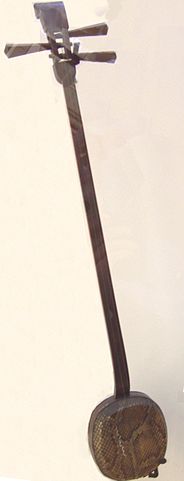
The sanxian is a lute with three strings, a long neck, and no fingerboard. It is played using a large animal-bone plectrum or with the fingers. The body of a sanxian is traditionally made from reptile skin; in the Realm this is usually snake skin, but might also be angler lizard, or, most impressively, skin from a tyrant lizard or other huge foreign beast. In addition to plucking the strings, a sanxian player can produce sound by striking the body.
Erhu
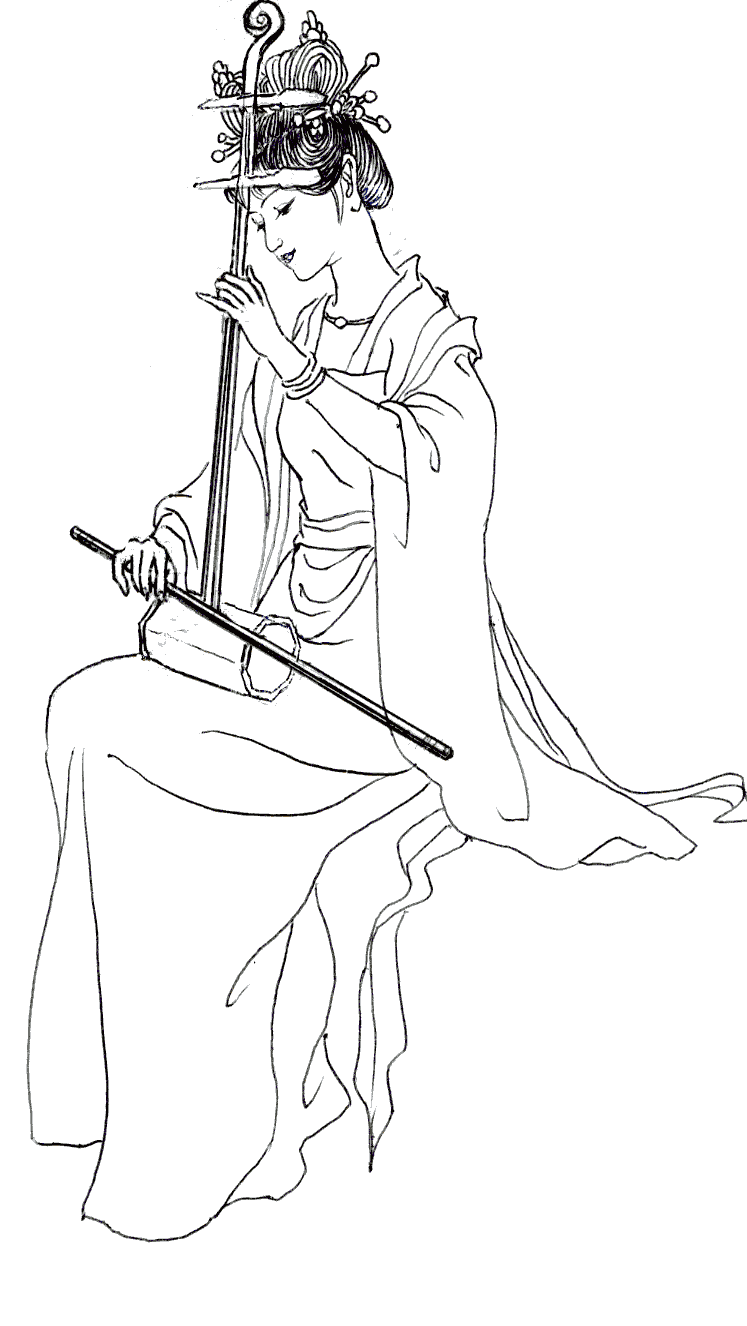
The erhu is a two-stringed fiddle which, like the sanxian, lacks a fretboard. The erhu is often called the Mother of Strings for its clear, powerful notes. Pieces for the erhu are often somber and contemplative. Some composers use the plucked erhu, which is more muted and muddy compared to the bow, but evokes a different emotional tone.
Guzheng
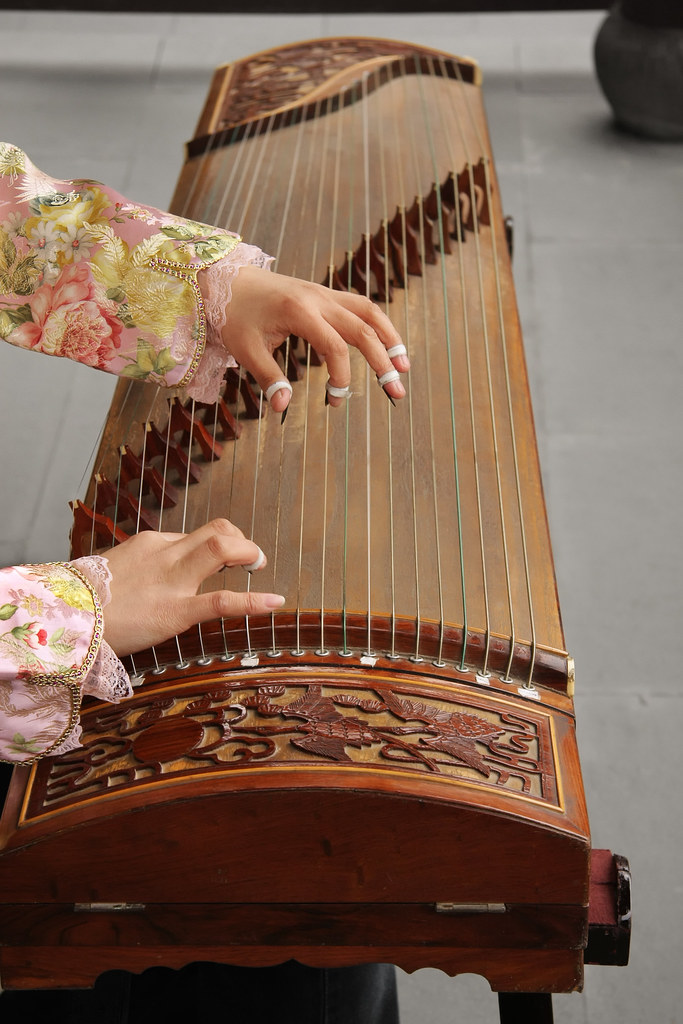
The guzheng is a large zither instrument with between 14 and 21 strings. The strings of the guzheng are traditionally made of silk or of brass, especially in the luxurious guzheng favored by the Dynasty. The guzheng player wears picks on her fingers made from toirtoiseshell, ivory, or jade. The guzheng has a huge range and slightly twangy sound. The right hand is used to play notes and the left to add ornamentation or to play other notes in parallel.
Bianqing
The bianqing is a rack of hanging chimes, made either from stone or from raw jade. When struck with a mallet, the chimes produce a refined ringing sound. The bianqing is a very large instrument which is difficult to relocate, so it is primarily a court, theater, and performance instrument rather than one which is used in more casual environments like teahouses or street performances.
Zhu
The zhu is a percussion instrument consisting of a tapered box with an open top, played by striking a central baton against the bottom face.
Tanggu
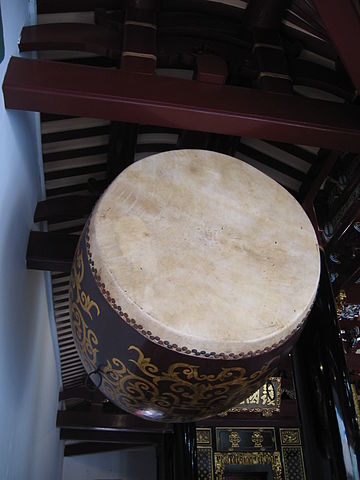
The tanggu is a variety of standing drum.
Dizi
The dizi is a bamboo transverse flute, held horizontally. The body of the dizi is long, which allows it to rest on the left shoulder when played over the right shoulder. Because the dizi is relatively cheap and easy to make, it is one of the most common instruments on the Isle. A cousin to the dizi is the xiao, a vertical bamboo flute which does not require a vibrating membrane. The xiao is characteristic of the Western Isle.
The dizi is the style of flute played by Wei Wuxian in The Untamed.
Sheng
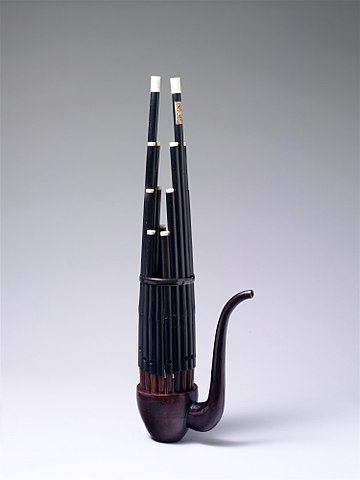
The sheng is a reed instrument consisting of many different vertical pipes, played by holes at the bottom of each pipe. Along with the dizi and the erhu, the sheng is one of the oldest instruments still played in the Realm. The sheng can be played with both inhaled and exhaled breath, which is why the sheng family are known as “breathing” instruments.
Vocal Performance
In addition to the instruments listed above, the Realm also uses plenty of vocal performance in its music. Solo performances and group performances are both common, and usually set to music; a capela performances are not typical. Vocal talent is determined primarily by ability to structure more than one’s ability to imbue their performance with personal characteristics.
Major Contemporary Styles
Some contemporary styles include:
The Elegant River style originates from the Imperial River valley and focuses on smooth, slow forms with many subtle layers. Elegant River music is appropriate for a night of appreciation in a private salon.
The Jade Cockerel style emerges from Wàn musical theater. It features many vocal performances which show off technical mastery, sliding between difficult registers with grace. Jade Cockerel music is appropriate for public performance at a large venue.
The Summer Rabbit style focuses on swinging movements, high-energy performances, and consistent beats that encourage dancing and swinging. Summer Rabbit music is appropriate for a lively ball or a summer night’s swing.
The Eight Winds style is extremely contemporary and highly improvisational. It encourages experimentation and expression, with a focus on classic instruments like the erhu and the sheng. The style emerged from elite circles in the northwestern Isle, who were attempting to one up one another with skillful improvised pieces. The Eight Winds style is popular for devotees of music who want something avant garde and novel.